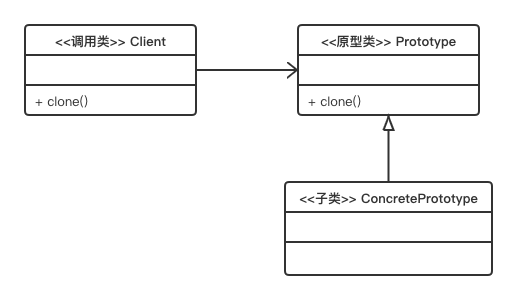23种设计模式(4) - 原型模式
1、定义
用原型实例指定创建对象的种类,并且通过拷贝这些原型创建新的对象。
2、UML图

3、组成
- 原型类:用来作拷贝的类,实现了
Cloneable类,并重写了clone方法。重写Cloneable方法才能使用clone方法,否则会报CloneNotSupportedException的异常;重写clone方法是因为该方法原来是protected类型的,不重写不能调用该方法。
4、代码
// 原型类
public class Prototype implements Cloneable {
private String name;
// 引用类型变量
private Car car;
@Override
protected Prototype clone() throws CloneNotSupportedException {
Prototype prototype = (Prototype) super.clone();
// 引用类型需要深复制
prototype.car = (Car) car.clone();
return prototype;
}
public Prototype(String name, Car car) {
this.name = name;
this.car = car;
}
// get、set方法省略 ...
public void show(){
System.out.println("我的名字:" + name + ":::::: 车的名字:" + car.getName());
}
}
public class Car implements Cloneable{
private String name;
public Car(String name) {
this.name = name;
}
// get、set方法省略 ...
@Override
protected Object clone() throws CloneNotSupportedException {
return super.clone();
}
}
// 引用类
public class Main {
public static void main(String[] args) throws CloneNotSupportedException {
Prototype prototype = new Prototype("原型1", new Car("原型1的CAR"));
Prototype prototype2 = prototype.clone();
// 修改引用类的属性,看是否会影响第一个类
prototype2.getCar().setName("原型2的CAR");
prototype.show();
prototype2.show();
}
}
运行结果:
我的名字:原型1:::::: 车的名字:原型1的CAR
我的名字:原型1:::::: 车的名字:原型2的CAR
5、优缺点
- 使用原型模式比直接new一个对象的性能要好的多,因为
clone方法是Java本地方法,它直接操作二进制流来创建对象,特别是复制大对象时,性能相差较明显。 - 需要注意,原型模式是直接在内存中操作二进制数据流的,不会去执行构造方法,而且类变量的访问权限级别也能被忽略。
- 深拷贝与浅拷贝:Object类的clone方法只会拷贝对象中的基本的数据类型(基本类型及封装类型,String类型也会被拷贝),对于数组、容器对象、引用对象等都不会拷贝,只会复制对象的引用,这就是浅拷贝。如果要实现深拷贝,必须将原型模式中的数组、容器对象、引用对象等另行拷贝。
6、适用场景
如果项目中要频繁复制新对象,或是被复制对象比较复杂,可以考虑原型模式。


 浙公网安备 33010602011771号
浙公网安备 33010602011771号